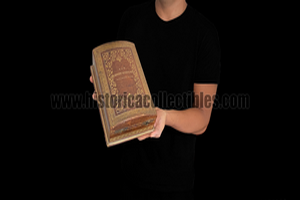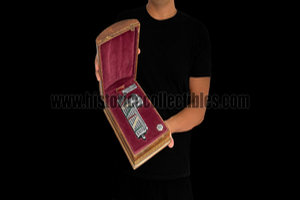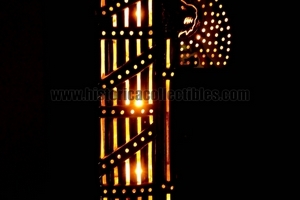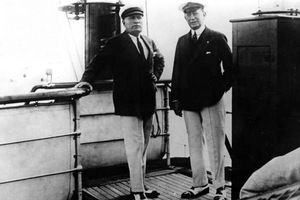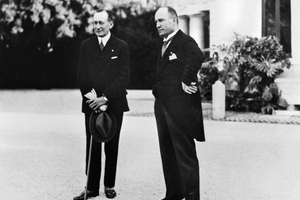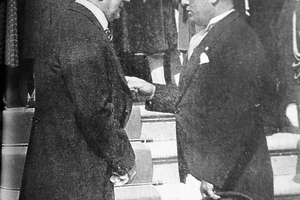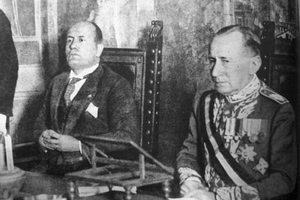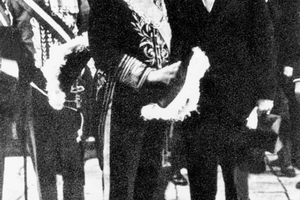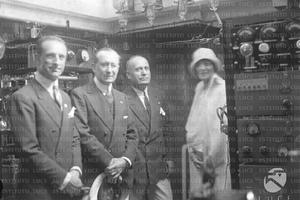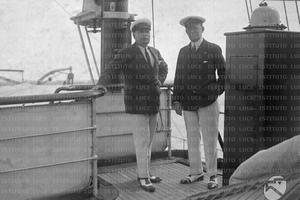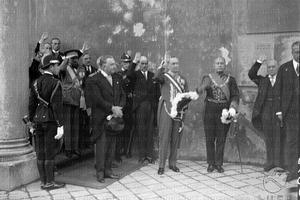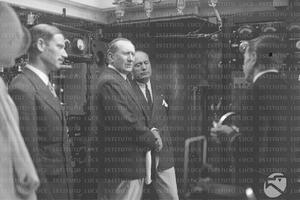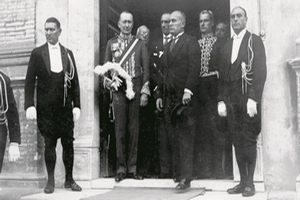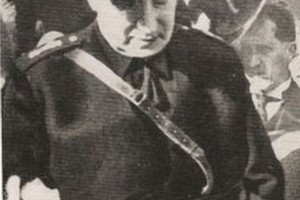Fascio, M. Buccellati, Gift to S.E. Il Duce BENITO MUSSOLINI by Guglielmo Marconi, 1927
Extraordinary silver fascio emblem with box, made by Mario Buccellati and commissioned by Guglielmo Marconi who gave it as a gift "TO HIS EXCELLENCE BENITO MUSSOLINI - Prime Minister of Italy" on the occasion of the International Conference of Electrotechnics and Chemistry, which took place on 21 September 1927 at Villa Torlonia, the Duce's residence in Rome.
Guglielmo Marconi, with this gift, certainly wanted to express his satisfaction as the Conference was promoted by Benito Mussolini himself, towards whom he felt great admiration and friendship and who supported progressive causes in the electrotechnical field, so much so that he expressed it to him in a speech held in the Senate in 1926 as follows: "I claim the honor of having been the first fascist in radiotelegraphy, the first to recognize the usefulness of bringing electric rays together in a bundle, as the Honorable Mussolini was the first to recognize in the political field the need to bring together the healthy energies of the country for the greater greatness of Italy".
And so, on September 21, 1927, precisely on the occasion of the Conference, Guglielmo Marconi made materialize in this gift what he declared in his 1926 speech: A beam within which is "collected" the light which is released through small holes in " light beams" to be understood as the tangible "electric rays" previously alluded to in 1926.
In addition to Guglielmo Marconi, the most illustrious people of the time participated in this conference: in fact, there were sixty-one scientists from fourteen nations. At the Campidoglio Marconi held the speech for the national commemoration of Volta and at Villa Torlonia Mussolini expressed to those present "his satisfaction that the Italian and Roman idea, which is also represented in Volta and inspires the fascist government, has rediscovered on this occasion so much correspondence between such conspicuous intellectuals of each nation". The conference was unprecedented for the number of illustrious guests, including 12 Nobel Prize winners, and for the grandeur of the organization.
The Casket, made of leather-lined wood, features the dedication on the upper part of the lid: "A. S. E. BENITO MUSSOLINI - PRIME MINISTER OF ITALY" framed in Greek style and very fine spiral decorations, all perfectly imprinted in pure gold.
Inside, placed in a special compartment covered in purple velvet, there is an extraordinary silver fasces, completely handmade and signed by Mario Buccellati, one of the most famous Italian jewelers in the world.
The Fascio can be dismantled into two parts and in its base there is an articulated series of light bulbs (4) which, connected to an electrical wiring placed inside the box and powered by a battery, are turned on by pressing a button, thus releasing the light through the holes and lozenges present on the upper part of the bundle on which enamels in Italian colors are also applied.
A silver plate with the signature of Guglielmo Marconi dated 21.9.1927 was placed inside the box, in memory of that event.
With this particular gift Guglielmo Marconi certainly wanted to highlight in the eyes of the Duce, his figure as a man dedicated to the Fascist cause, in which he saw the project of conquering the scientific enterprise take off, where each will be hailed as a "new triumph of Italian genius".
Heirloom of extraordinary historical importance. Unique.
Guglielmo Marconi, born in Bologna in 1874 to a family of landowners, with an Italian father and an Irish mother, began to show his interest in scientific disciplines at a very young age, with an intense self-taught activity aimed mainly at electrical engineering.
At twenty he began experiments on electromagnetic waves and the radiation of electromagnetic signals, carried out largely in his father's villa in Pontecchio, near Bologna.
In 1895 Marconi carried out the experiment that would revolutionize his life and innovate the field of telecommunications.
He managed to intercept the signal radiated by a transmitter located 2 km away from the receiver, despite the fact that between the two there was a hill, since then known as "the hill of the radio". The signal - dot, dot, dot - was made to correspond to the "S" in Morse code.
He invented the radio and was defined as "the Italian genius who gave voice to silence".
The discovery, not initially appreciated in Italy, had great importance in England where Marconi was introduced to the British General Post Office and had the opportunity to demonstrate the effectiveness of his great intuition, obtaining consensus and admiration very quickly.
In 1887, at just 22 years old, he filed the first patent on the "wireless telegraph", and founded the "Marconi wireless Telegraph Company".
Faced with so many recognitions, the Italian authorities also wanted to make use of the ability of the young scientist who was requested by the Minister of the Merchant Navy to conduct experiments in Italy.
The exasperated nationalistic spirit of the beginning of the twentieth century, however, was an obstacle for Marconi, who thought and worked with a cosmopolitan and international imprint, surrounded by collaborators from all over the world, while the vision of the time was wary of what was "foreign" ".
In 1901 the first SOS messages across the Atlantic were received via headphones: the young man, not yet thirty years old, covered himself in glory.
Marconi received an honorary degree from the Faculty of Engineering of Bologna in 1904, and many other prestigious awards. In 1909 he was awarded the Nobel Prize for Physics - which we remember today - together with Karl Ferdinand Braun, with the following motivation: "In recognition of their merits for the development of wireless telegraphy".
He was the first Italian to be awarded for physics and the youngest ever of all those awarded up to then.
In December 1914 he was appointed senator of the kingdom for the twentieth category.
When the Titanic sank after sending the first SOS signal via radio, Marconi was in New York and went to the port to welcome the survivors who then awarded him a gold plaque as a sign of gratitude.
Marconi himself gave a prize to the radio operator who had remained in his place to launch an SOS until the water had invaded the bridge.
D'Annunzio defined him as a "magician" who with his power penetrated the depths of the seas.
In 1930 he turned on the lights of the Sydney Town Hall from Genoa, in 1931 he inaugurated the Vatican radio; in 1933 he began his first experiments on radar.
He was president of the National Research Council (the CNR) and tried to guarantee the Institute autonomy from political power and propaganda; he was president of the Royal Academy of Italy (currently the Accademia Nazionale dei Lincei) and of the Treccani Institute.
Appointed professor of electromagnetic waves at the University of Rome, he was part of the famous Via Panisperna group, where Enrico Fermi already worked.
In the second phase of his life Marconi dedicated himself to the study of short waves, in particular on his yacht "Elettra", and to creating a first draft of the radar.
He died on July 20, 1937.
Radio stations all over the world (a world marked, in those years, by very profound political and ideological conflicts) managed to agree to interrupt the broadcasts at the same time, and for two minutes the airwaves were empty and silent again, as they had been before a self-taught twenty-year-old did not stubbornly start his experiments on wireless telegraphy in the family villa in Pontecchio.
Marconi was a great "systems engineer", that is, an application scientist, capable of coordinating his own and others' knowledge and works but also of making rigorous technical-cultural choices, always accompanied by concrete and effective experimentation which served as a "forerunner" for the discoveries of future.
He was awarded 16 Honoris Causa degrees, 25 honors, 12 honorary citizenships.
He was a man who imagined the scientific future of the world and who knew how to grasp the challenges of the future.
What is striking in Marconi's life is the circumstance, common to many brilliant discoverers, of initially not being listened to at home and finding help elsewhere.
Marconi, for example, managed by virtue of his connection with England to obtain the recognition he deserved at a young age.
Strongly courted by the regime from the beginning, Marconi decided to join fascism, which offered him prominent positions in national bodies, so much so that in one of his speeches he stated: "I claim the honor of having been the first fascist in radiotelegraphy, the first to recognize the usefulness of bringing together the electrical rays, just as Mussolini was the first to recognize in the political field the need to bring together the healthy energies of the country for the greater greatness of Italy".
Benito Mussolini, in a speech to the Senate on 9 December 1937, stated: "No wonder that Marconi embraced, from the day before, the doctrine of the Black Shirts, proud to have him in their ranks". On the occasion of the 19th meeting of the Italian Society for the Progress of Sciences which was held from 7 to 15 September 1930 jointly in Bolzano and Trento, he began his inaugural speech with the words: "My greeting is exultant for the satisfaction of finding myself among the brothers of Trentino in a great, purely Italian demonstration which takes place on the soil reconquered from the great Mother under the guidance of the victorious King, while the flag of the Homeland flies safely over the Brenner Pass and the vigilant and alert mind of the Duce presides over and provides for the fulfillment of our destinies".
Mario Buccellati (Ancona, 29 April 1891 – Milan, 5 May 1965) was an Italian goldsmith, jeweler and entrepreneur, founder of the Mario Buccellati jewelry company of the same name, later renamed Buccellati; he also practiced the art of silversmith, engraver and setter of precious stones.
Born into a Lombard family, after the death of his father, which struck him at an early age, he returned to his homeland with his mother and brothers. At fourteen he was forced to work to support his family and was hired as an apprentice in a goldsmith's workshop in Milan.
In 1915 he was conscripted to fight in the First World War; during a battle he was wounded so he received a war merit cross. At the end of the conflict he was discharged and returned to the goldsmith's shop that he had left when he went to war, but he found another master who had taken over his business from his old master. He in turn took over the shop in 1919 and, after a few years, decided to open another in Rome in via Condotti in 1925 which was followed by a third in Florence in 1929.
In 1921 he was already a famous artist abroad: in fact he was invited to exhibit his jewels in an exhibition in Madrid; from that event came further admiration for him, who had kings, popes, industrialists and film stars among his clients. In the Milanese shop, each jewel produced constituted a unique piece, which was then cataloged and described with all its peculiarities in specific registers still partially preserved by the heirs.
Important was the friendship with Gabriele D'Annunzio who was a great admirer of Mario's goldsmith art and therefore an admirer of the jewels he produced, which he ordered and purchased in considerable quantities: obviously D'Annunzio, showing off Buccellati's jewels during meetings worldly in the Vittoriale of the Italians, he was a valid ambassador of the goldsmith's production, later called "Mastro Paragon Coppella" by the poet and Prince of goldsmiths.
He also established himself as a silversmith, engraver and setter of precious stones; furthermore, in the period of economic shortage caused by war events, he knew how to work copper and steel equally well into artefacts which are preserved in museums.
In 1956 Mario opened a new store on Fifth Avenue in New York and in 1958 another on Worth Avenue in Palm Beach, establishing the company that he would manage until the last days of his life.
Mario Buccellati museum contains over 200 jewels created by the artist, which were collected and kept by his heirs. Periodically many pieces are exhibited during art exhibitions in various parts of the world.

